Source Analysis of Ozone Pollution in Liaoyuan City’s Atmosphere Based on Machine Learning Models and HYSPLIT Clustering Method
Abstract
1. Introduction
2. Methods and Data
2.1. Random Forest Model
2.2. Support Vector Machine Model
2.3. Artificial Neural Network Model
2.4. HYSPLIT Backward Trajectory Cluster Analysis
2.5. Simulation of O3 and Its Validation
2.6. Data Sources
3. Results and Discussion
3.1. Analysis of Atmospheric Pollution Characteristics in Liaoyuan City
3.1.1. Analysis of Spatial Distribution Characteristics
3.1.2. Correlation Analysis with Meteorological Factors
3.1.3. Annual Variation Characteristics of Pollution
3.1.4. Seasonal Variation Characteristics of Pollution
3.1.5. Monthly Variation Characteristics of Pollution
3.2. Factors Affecting Ozone Concentrations
3.2.1. Comparative Study of Machine Learning Models
3.2.2. Analysis of Regional Transport
3.2.3. Analysis of Heavy Pollution Episodes
3.2.4. Analysis of Simulation of Air Pollution
4. Conclusions
Supplementary Materials
Author Contributions
Funding
Institutional Review Board Statement
Informed Consent Statement
Data Availability Statement
Conflicts of Interest
References
- Li, K.; Jacob, D.J.; Liao, H.; Shen, L.; Zhang, Q.; Bates, K.H. Anthropogenic drivers of 2013–2017 trends in summer surface ozone in China. Proc. Natl. Acad. Sci. USA 2019, 116, 422–427. [Google Scholar] [CrossRef] [PubMed]
- Ahn, J.-W.; Dinh, T.-V.; Park, S.-Y.; Choi, I.-Y.; Park, C.-R.; Son, Y.-S. Characteristics of biogenic volatile organic compounds emit ted from major species of street trees and urban forests. Atmos. Pollut. Res. 2022, 13, 101470. [Google Scholar] [CrossRef]
- Oumami, S.; Arteta, J.; Guidard, V.; Tulet, P.; Hamer, P.D. Evaluation of Isoprene Emissions from the Coupled Model SURFEX-MEGANv2.1. EGUsphere 2023, 1–30. Available online: https://egusphere.copernicus.org/preprints/2023/egusphere-2023-2206/ (accessed on 11 June 2025). [CrossRef]
- Chen, Z.; Liu, J.; Cheng, X.; Yang, M.; Wang, H. Positive and negative influences of landfalling typhoons on tropospheric ozone over southern China. Atmos. Chem. Phys. 2021, 21, 16911–16923. [Google Scholar] [CrossRef]
- Pan, Q.; Harrou, F.; Sun, Y.J. A comparison of machine learning methods for ozone pollution prediction. J. Big Data 2023, 10, 63. [Google Scholar] [CrossRef]
- Cheng, Y.; He, L.Y.; Huang, X.F. Development of a high-performance machine learning model to predict ground ozone pollution in typical cities of China. J. Environ. Manag. 2021, 299, 113670. [Google Scholar] [CrossRef]
- Lu, H.; Xie, M.; Liu, X.; Liu, B.; Jiang, M.; Gao, Y.; Zhao, X. Adjusting prediction of ozone concentration based on CMAQ model and machine learning methods in Sichuan-Chongqing region, China. Atmos. Pollut. Res. 2021, 12, 101066. [Google Scholar] [CrossRef]
- Ma, R.; Ban, J.; Wang, Q.; Li, T. Statistical spatial-temporal modeling of ambient ozone exposure for environmental epidemiology studies: A review. Sci. Total Environ. 2020, 701, 134463. [Google Scholar] [CrossRef]
- Jumin, E.; Zaini, N.; Ahmed, A.N.; Abdullah, S.; Ismail, M.; Sherif, M.; Sefelnasr, A.; El-Shafie, A. Machine learning versus linear regression modelling approach for accurate ozone concentrations prediction. Eng. Appl. Comp. Fluid Mech. 2020, 14, 713–725. [Google Scholar] [CrossRef]
- Zhen, L.; Chen, B.; Wang, L.; Yang, L.; Xu, W.; Huang, R.-J. Data imbalance causes underestimation of high ozone pollution in machine learning models: A weighted support vector regression solution. Atmos. Environ. 2025, 343, 120952. [Google Scholar] [CrossRef]
- Yang, X.-T.; Kang, P.; Wang, A.-Y.; Zang, Z.-L.; Liu, L. Prediction of ozone pollution in Sichuan Basin based on random forest model. Environ. Sci. 2024, 45, 2507–2515. [Google Scholar] [CrossRef]
- Huang, Y.; Wang, Q.; Ou, X.; Sheng, D.; Yao, S.; Wu, C.; Wang, Q. Identification of response regulation governing ozone formation based on influential factors using a random forest approach. Heliyon 2024, 10, e36303. [Google Scholar] [CrossRef]
- Abdul Aziz, F.A.B.; Abd. Rahman, N.; Mohd Ali, J. Tropospheric Ozone Formation Estimation in Urban City, Bangi, Using Artificial Neural Network (ANN). Comput. Intell. Neurosci. 2019, 2019, 6252983. [Google Scholar] [CrossRef]
- Su, X.-Q.; An, J.-L.; Zhang, Y.-X.; Liang, J.-S.; Liu, J.-D.; Wang, X. Application of support vector machine regression in ozone forecasting. Huan Jing Ke Xue = Huanjing Kexue 2019, 40, 1697–1704. [Google Scholar] [CrossRef]
- Balogun, A.L.; Tella, A. Modelling and investigating the impacts of climatic variables on ozone concentration in Malaysia using correlation analysis with random forest, decision tree regression, linear regression, and support vector regression. Chemosphere 2022, 299, 134250. [Google Scholar] [CrossRef] [PubMed]
- Juarez, E.K.; Petersen, M.R. A Comparison of Machine Learning Methods to Forecast Tropospheric Ozone Levels in Delhi. Atmosphere 2022, 13, 46. [Google Scholar] [CrossRef]
- Luna, A.S.; Paredes, M.L.L.; De Oliveira, G.C.G.; Corrêa, S. Prediction of ozone concentration in tropospheric levels using artificial neural networks and support vector machine at Rio de Janeiro, Brazil. Atmos. Environ. 2014, 98, 98–104. [Google Scholar] [CrossRef]
- Lin, X.; Tong, J.-L.; Wang, Y.-F.; Chen, Y.-X.; Liu, Y.-L.; Zhang, X.; Ao, C.-J.; Liu, H.-T. Analysis of Causes and Sources of Summer Ozone Pollution in Rizhao Based on CMAQ and HYSPLIT Models. Huan Jing Ke Xue = Huanjing Kexue 2023, 44, 098–3107. [Google Scholar] [CrossRef]
- Zhang, K.; Xu, J.; Huang, Q.; Zhou, L.; Fu, Q.; Duan, Y.; Xiu, G. Precursors and potential sources of ground-level ozone in suburban Shanghai. Front. Environ. Sci. Eng. 2020, 14, 92. [Google Scholar] [CrossRef]
- Breiman, L. Random Forests. Mach. Learn. 2001, 45, 5–32. [Google Scholar] [CrossRef]
- Brokamp, C.; Rao, M.; Ryan, P.; Jandarov, R. A comparison of resampling and recursive partitioning methods in random forest for estimating the asymptotic variance using the infinitesimal jackknife. Stat 2017, 6, 360–372. [Google Scholar] [CrossRef]
- Halabaku, E.; Bytyçi, E. Overfitting in Machine Learning: A Comparative Analysis of Decision Trees and Random Forests. Intell. Autom. Soft. Comput. 2024, 39, 987–1006. [Google Scholar] [CrossRef]
- Lu, W.Z.; Wang, W.J. Potential assessment of the “support vector machine” method in forecasting ambient air pollutant trends. Chemosphere 2005, 59, 693–701. [Google Scholar] [CrossRef] [PubMed]
- Evgeniou, T.; Pontil, M. Machine Learning and Its Applications; Springer: Berlin/Heidelberg, Germany, 1999; pp. 249–257. [Google Scholar]
- Sewell, M. Structural Risk Minimization. Ph.D. Dissertation, Department of Computer Science, University College London, London, UK, 2008. [Google Scholar]
- Haykin, S. Neural Networks: A Comprehensive Foundation; Prentice Hall PTR: New Jersey, NJ, USA, 1994. [Google Scholar]
- Elharrouss, O.; Akbari, Y.; Almadeed, N.; Al-Maadeed, S. Backbones-review: Feature extractor networks for deep learning and deep reinforcement learning approaches in computer vision. Comput. Sci. Rev. 2024, 53, 100645. [Google Scholar] [CrossRef]
- Stein, A.F.; Draxler, R.R.; Rolph, G.D.; Stunder, B.J.B.; Cohen, M.D.; Ngan, F. NOAA’s HYSPLIT atmospheric transport and dispersion modeling system. Bull. Am. Meteorol. Soc. 2015, 96, 2059–2077. [Google Scholar] [CrossRef]
- Cui, L.; Song, X.; Zhong, G. Comparative analysis of three methods for HYSPLIT atmospheric trajectories clustering. Atmosphere 2021, 12, 698. [Google Scholar] [CrossRef]
- Skamarock, W.C.; Klemp, J.B.; Dudhia, J.; Gill, D.O.; Liu, Z.; Berner, J.; Wang, W.; Powers, J.G.; Duda, M.G.; Barker, D.M.; et al. A description of the advanced research WRF model version 4. Natl. Cent. Atmos. Res. 2019, 145, 550. [Google Scholar]
- Li, M.; Liu, H.; Geng, G.; Hong, C.; Liu, F.; Song, Y.; Tong, D.; Zheng, B.; Cui, H.; Man, H.; et al. Anthropogenic emission inventories in China: A review. Natl. Sci. Rev. 2017, 4, 834–866. [Google Scholar] [CrossRef]
- Yildizhan, H.; Udriștioiu, M.T.; Pekdogan, T.; Ameen, A. Observational study of ground-level ozone and climatic factors in Craiova, Romania, based on one-year high-resolution data. Sci. Rep. 2024, 14, 26733. [Google Scholar] [CrossRef]
- Chu, P.; Zhang, L.; Wang, Z.; Wei, L.; Liu, Y.; Dai, H.; Duan, E.; Deng, J. Synergistic catalytic elimination of NOX and VOCs: State of the art and open challenges. Surf. Interfaces 2024, 51, 104718. [Google Scholar] [CrossRef]
- Zhang, K.; Chen, Q.; Hong, Y.; Ji, X.; Chen, G.; Lin, Z.; Zhang, F.; Wu, Y.; Yi, Z.; Zhang, F.; et al. Elucidating contributions of meteorology and emissions to O3 variations in coastal city of China during 2019–2022: Insights from VOCs sources. Environ. Pollut. 2025, 366, 125491. [Google Scholar] [CrossRef] [PubMed]
- Li, Y.; Ye, C.; Ma, X.; Tan, Z.; Yang, X.; Zhai, T.; Liu, Y.; Lu, K.; Zhang, Y. Radical chemistry and VOCs-NOX-O3-nitrate sensitivity in the polluted atmosphere of a suburban site in the North China Plain. Sci. Total Environ. 2024, 947, 174405. [Google Scholar] [CrossRef] [PubMed]
- Yao, T.; Ye, H.; Wang, Y.; Zhang, J.; Guo, J.; Li, J. Kolmogorov-Zurbenko filter coupled with machine learning to reveal multiple drivers of surface ozone pollution in China from 2015 to 2022. Sci. Total Environ. 2024, 949, 175093. [Google Scholar] [CrossRef] [PubMed]
- Zhang, M.; Liu, Y.; Xu, X.; He, J.; Ji, D.; Qu, K.; Xu, Y.; Cong, C.; Wang, Y. A Systematic Review on Atmospheric Ozone Pollution in a Typical Peninsula Region of North China: Formation Mechanism, Spatiotemporal Distribution, Source Apportionment, and Health and Ecological Effects. Curr. Pollut. Rep. 2025, 11, 9. [Google Scholar] [CrossRef]
- de Souza, A.; de Oliveira-Júnior, J.F.; Cardoso, K.R.A.; Gautam, S. Impact of vehicular emissions on ozone levels: A comprehensive study of nitric oxide and ozone interactions in urban areas. Geosyst. Geoenviron. 2025, 4, 100348. [Google Scholar] [CrossRef]
- Wang, Z.; Zhang, H.; Shi, C.; Ji, X.; Zhu, Y.; Xia, C.; Sun, X.; Zhang, M.; Lin, X.; Yan, S.; et al. Vertical and spatial differences in ozone formation sensitivities under different ozone pollution levels in eastern Chinese cities. Npj Clim. Atmos. Sci. 2025, 8, 30. [Google Scholar] [CrossRef]
- Tong, Z.; Yan, Y.; Kong, S.; Niu, X.; Ma, J. Improving ozone estimation during rainy-warm seasons from the perspective of weather systems based on machine learning. Sci. Total Environ. 2025, 958, 177975. [Google Scholar] [CrossRef]
- Wang, D.; Pu, D.; De Smedt, I.; Zhu, L.; Yang, X.; Sun, W.; Xia, H.; Song, Z.; Li, X.; Li, J.; et al. Evolution of global O3-NOX-VOCs sensitivity before and after the COVID-19 from the ratio of formaldehyde to NO2 from satellites observations. J. Environ. Sci. 2024, 156, 102–113. [Google Scholar] [CrossRef]
- Wu, S.; Hou, L.; Sun, X.; Liu, M.; Wang, N.; Li, R. Characterizing temporal trends and meteorological influences on ozone pollution in Shenyang region (2018–2021). Air Qual. Atmos. Health 2025, 18, 1169–1182. [Google Scholar] [CrossRef]
- Chu, W.; Li, H.; Ji, Y.; Zhang, X.; Xue, L.; Gao, J.; An, C. Research on ozone formation sensitivity based on observational methods: Development history, methodology, and application and prospects in China. J. Environ. Sci. 2024, 138, 543–560. [Google Scholar] [CrossRef]
- Wang, Y.; Ding, D.; Kang, N.; Xu, Z.; Yuan, H.; Ji, X.; Dou, Y.; Guo, L.; Shu, M.; Wang, X. Effects of combined exposure to PM2.5, O3, and NO2 on health risks of different disease populations in the Beijing-Tianjin-Hebei region. Sci. Total Environ. 2025, 958, 178103. [Google Scholar] [CrossRef] [PubMed]
- Wang, L.; Wan, B.; Yang, Y.; Fan, S.; Jing, Y.; Cheng, X.; Gao, Z.; Miao, S.; Zou, H. Atmospheric Boundary Layer Stability in Urban Beijing: Insights from Meteorological Tower and Doppler Wind Lidar. Remote Sens. 2024, 16, 4246. [Google Scholar] [CrossRef]
- Li, M.; Wang, R. Combined Catalytic Conversion of NOX and VOCs: Present Status and Prospects. Materials 2024, 18, 39. [Google Scholar] [CrossRef]
- Wang, C.; Li, J.; An, X.; Liu, Z.; Zhang, D. Sensitivity analysis and precursor emission sources reduction strategies of O3 for different pollution weather types based on the GRAPES-CUACE adjoint model. Atmos. Environ. 2024, 333, 120632. [Google Scholar] [CrossRef]
- Zhao, D.; Xin, J.; Wang, W.; Jia, D.; Wang, Z.; Xiao, H.; Liu, C.; Zhou, J.; Tong, L.; Ma, Y.; et al. Effects of the sea-land breeze on coastal ozone pollution in the Yangtze River Delta, China. Sci. Total Environ. 2022, 807, 150306. [Google Scholar] [CrossRef]
- Ma, L. Decomposition of China’s industrial environment pollution change based on LMDI. Geogr. Res. 2016, 35, 1857–1868. [Google Scholar]
- Boylan, J.W.; Russell, A.G. PM and light extinction model performance metrics, goals, and criteria for three-dimensional air quality models. Atmos. Environ. 2006, 40, 4946–4959. [Google Scholar] [CrossRef]
- Du, C.; Pei, J.; Feng, Z.J. Unraveling the complex interactions between ozone pollution and agricultural productivity in China’s main winter wheat region using an interpretable machine learning framework. Sci. Total Environ. 2024, 954, 176293. [Google Scholar] [CrossRef]
- Zheng, B.; Tong, D.; Li, M.; Liu, F.; Hong, C.; Geng, G.; Li, H.; Li, X.; Peng, L.; Qi, J.; et al. Trends in China’s anthropogenic emissions since 2010 as the consequence of clean air actions. Atmos. Chem. Phys. 2018, 18, 14095–14111. [Google Scholar] [CrossRef]
- Li, M.; Huang, X.; Yan, D.; Lai, S.; Zhang, Z.; Zhu, L.; Lu, Y.; Jiang, X.; Wang, N.; Wang, T.; et al. Coping with the concurrent heatwaves and ozone extremes in China under a warming climate. Sci. Bull. 2024, 69, 2938–2947. [Google Scholar] [CrossRef]
- Brown, J.; Bowman, C. Integrated Science Assessment for Ozone and Related Photochemical Oxidants; US Environmental Protection Agency: Washington, DC, USA, 2013.
- Cao, X.C.; Wu, X.C.; Xu, W.S.; Xie, R.; Xian, A.; Yang, Z. Pollution characterization, ozone formation potential and source apportionment of ambient VOCs in Sanya, China. Res. Environ. Sci. 2021, 34, 1812–1824. [Google Scholar]
- Wang, M.; Zheng, Y.F.; Liu, Y.J.; Li, Q.P.; Ding, Y.H. Characteristics of ozone and its relationship with meteorological factors in Beijing-Tianjin-Hebei Region. China Environ. Sci. 2019, 39, 2689–2698. [Google Scholar]

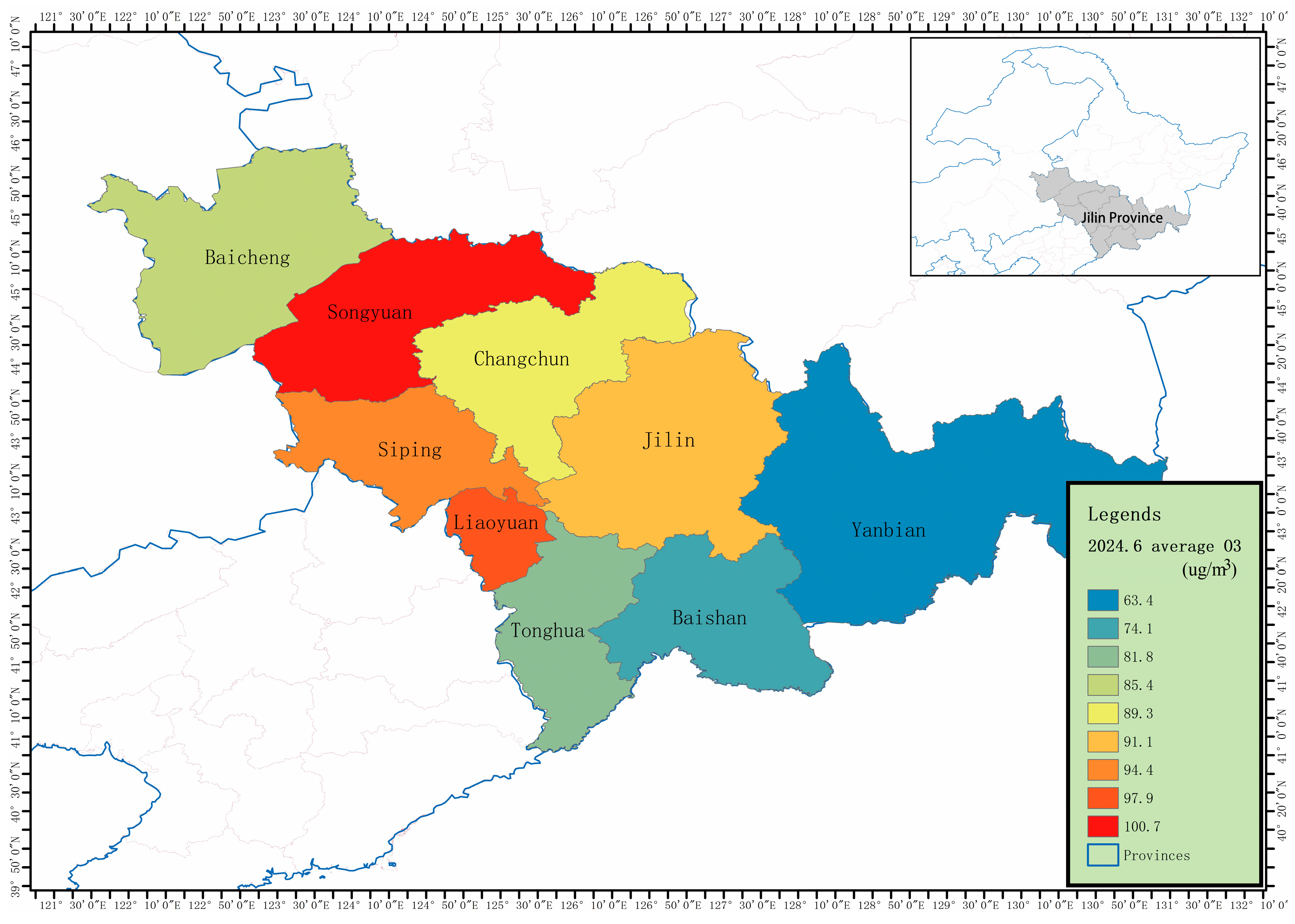
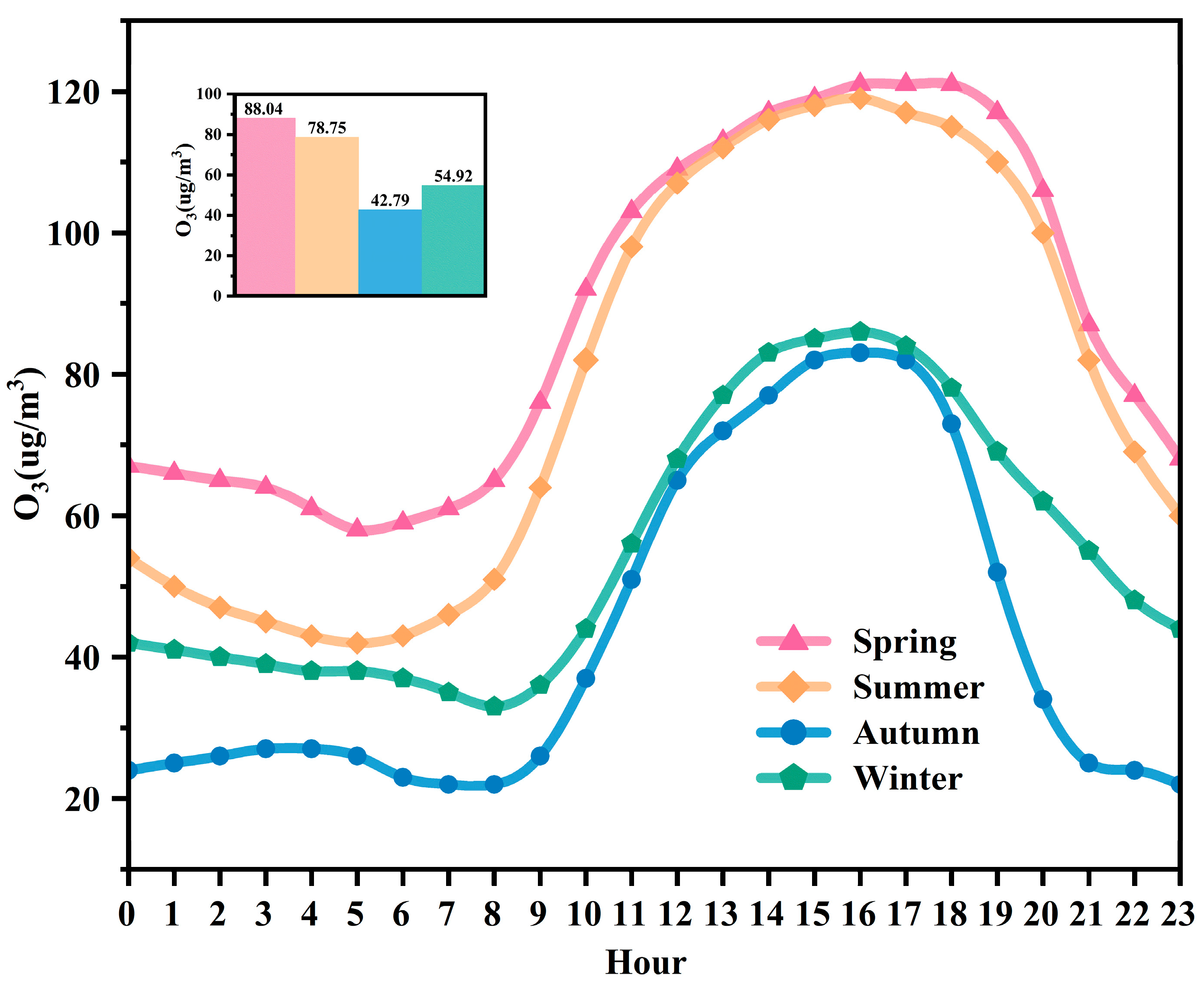

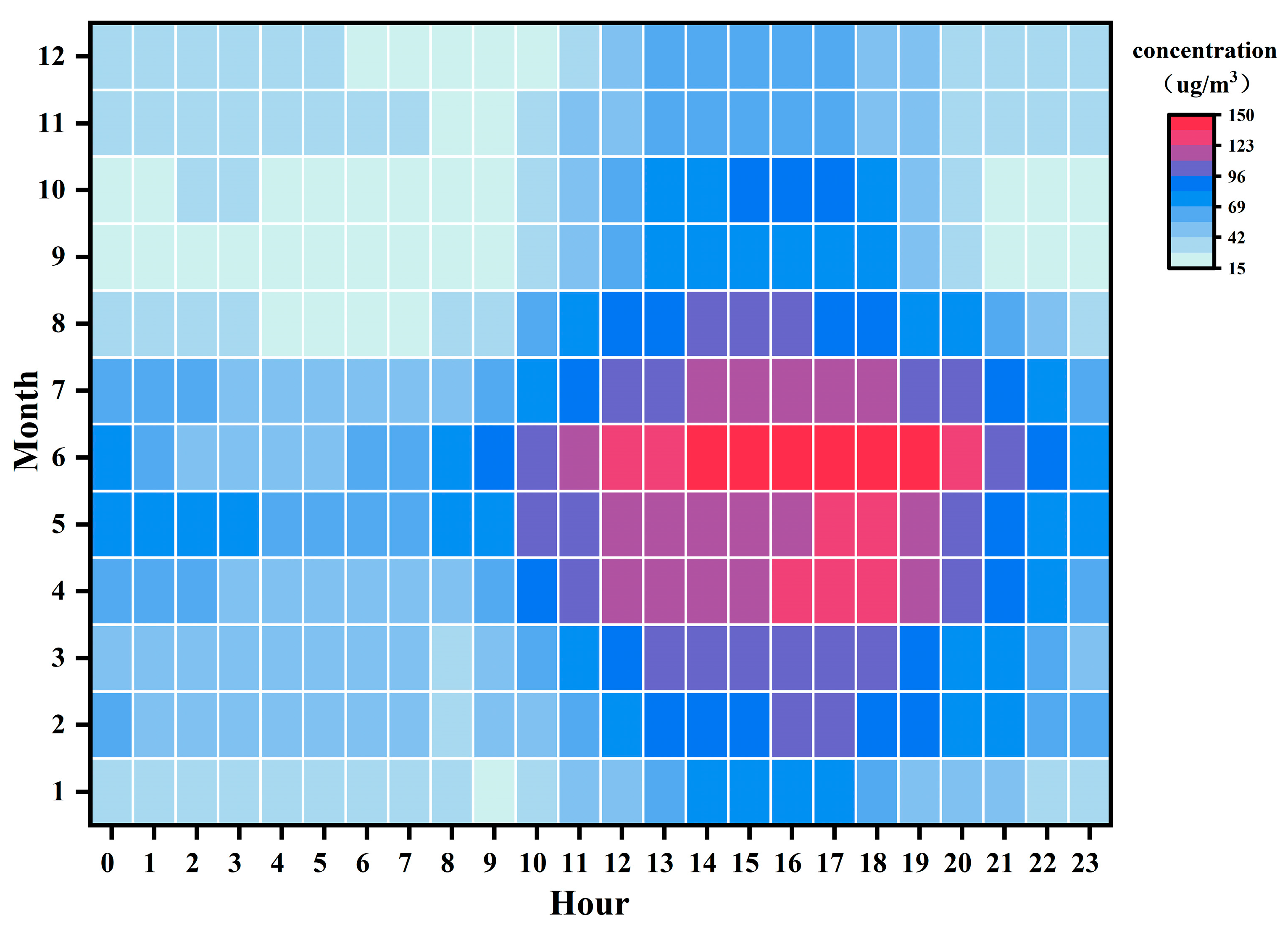


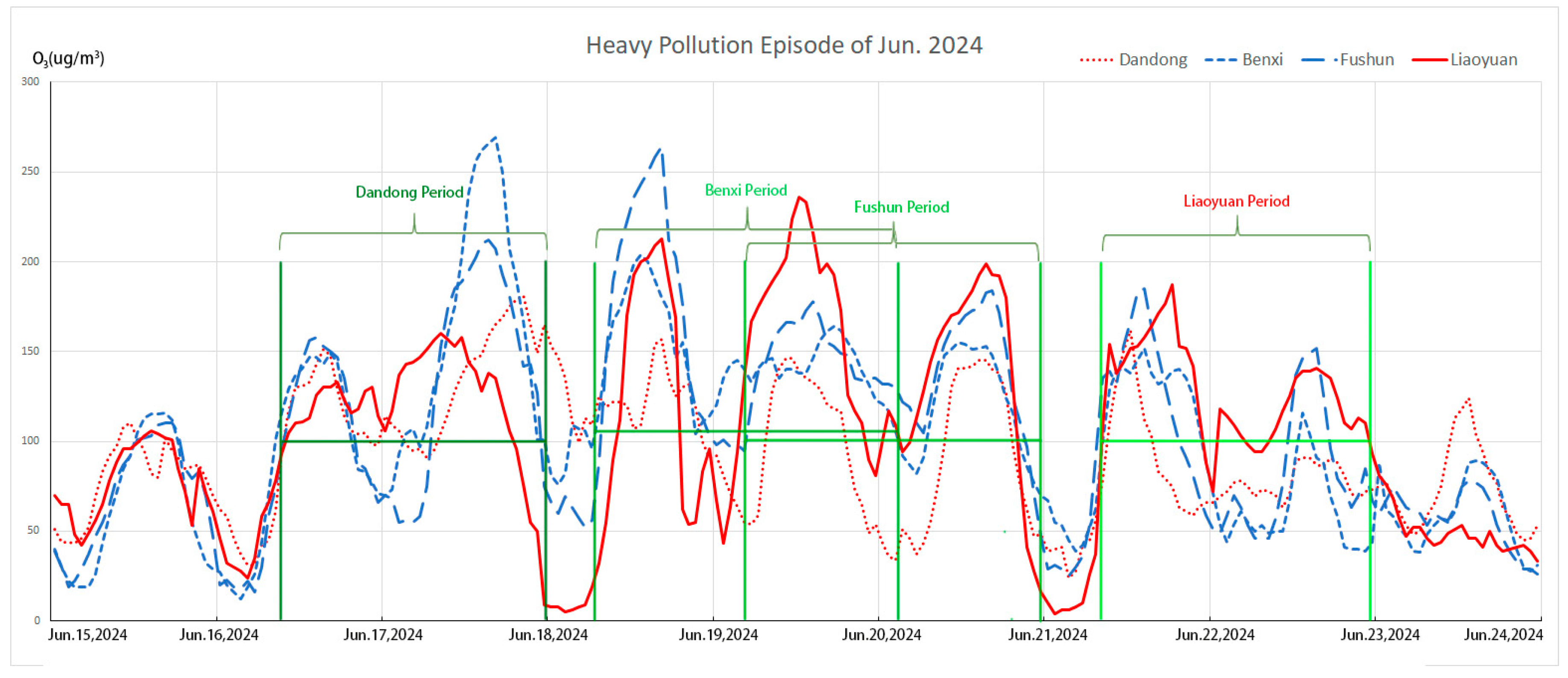


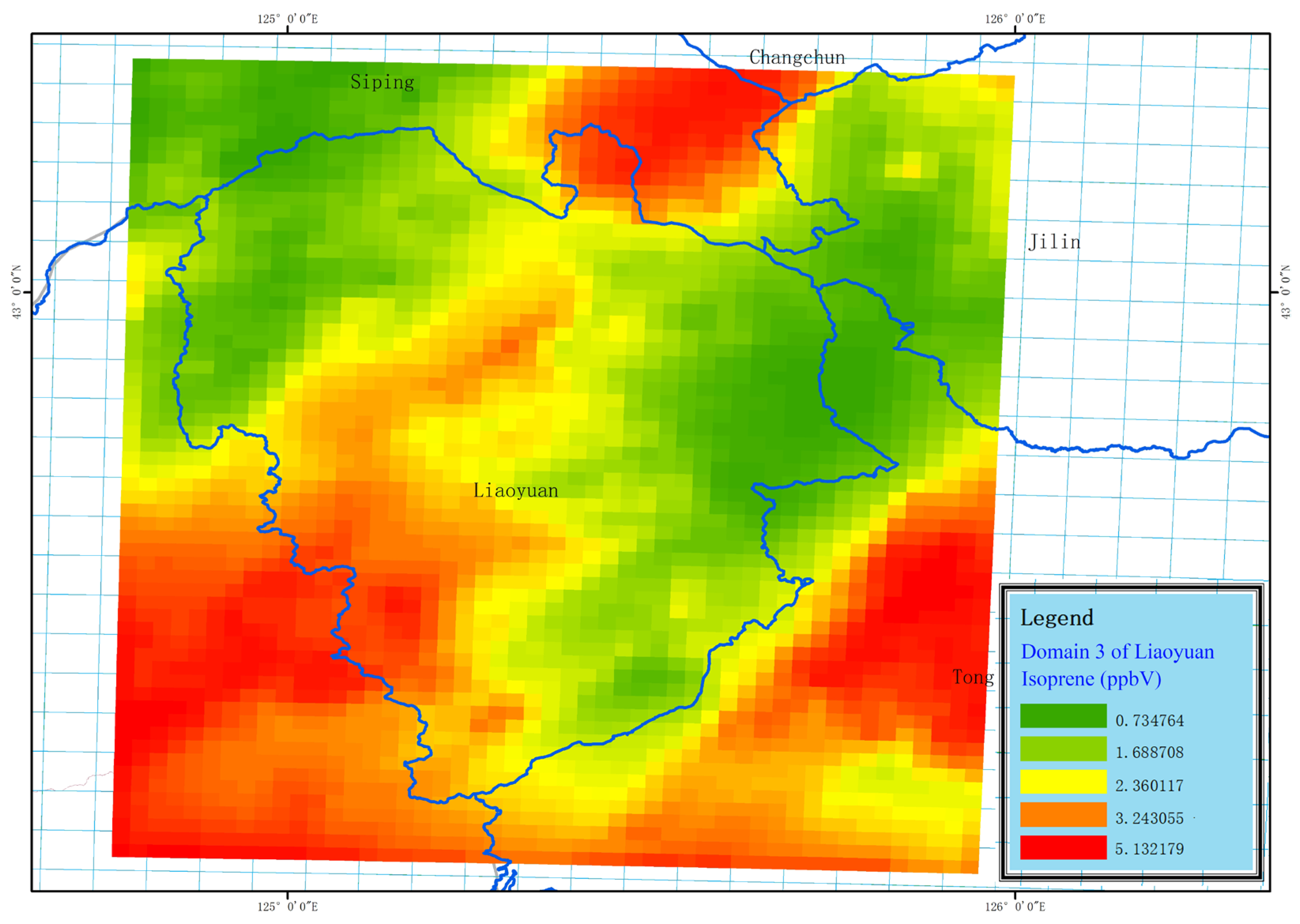
| Parameters | Settings |
|---|---|
| Microphysical Process Scheme | Thompson |
| Short-wave Radiation Scheme | Rapid Radiative Transfer Model |
| Long-wave Radiation Scheme | Rapid Radiative Transfer Model |
| Land surface Process Scheme | Noah Land Surface Model |
| Boundary Layer Scheme | YSU (Yonsei University) |
| Cumulus Parametric Scheme | Kain–Fritsch (New Eta) |
| Indicators | Formulas |
|---|---|
| MFB | |
| MFE | |
| R |
| Variables | PM2.5 | PM10 | SO2 | NO2 | O3 | CO | T | P | WS |
|---|---|---|---|---|---|---|---|---|---|
| PM2.5 | 1.000 | ||||||||
| PM10 | 0.900 ** | 1.000 | |||||||
| SO2 | 0.440 ** | 0.380 ** | 1.000 | ||||||
| NO2 | 0.470 ** | 0.410 ** | 0.290 ** | 1.000 | |||||
| O3 | −0.170 ** | −0.160 ** | −0.071 ** | −0.540 ** | 1.000 | ||||
| CO | 0.630 ** | 0.530 ** | 0.260 ** | 0.630 ** | −0.350 ** | 1.000 | |||
| T | −0.300 ** | −0.270 ** | −0.260 ** | −0.260 ** | 0.210 ** | −0.230 ** | 1.000 | ||
| P | −0.340 ** | −0.310 ** | −0.300 ** | −0.290 ** | 0.230 ** | −0.220 ** | 0.920 ** | 1.000 | |
| WS | −0.028 | 0.0093 | −0.030 | −0.090 ** | 0.059 ** | −0.099 ** | 0.240 ** | 0.0028 | 1.000 |
| Year | PM2.5 (%) | PM10 (%) | O3 (%) |
|---|---|---|---|
| 2021 | 65.52 | 3.45 | 31.03 |
| 2022 | 51.30 | 0.00 | 48.70 |
| 2023 | 39.10 | 10.90 | 50.00 |
| 2024 | 42.10 | 5.30 | 52.60 |
| ID | Variables | Categories | Value |
|---|---|---|---|
| 1 | NO2 | Monitoring Pollutants | 0.6579 |
| 2 | Second Quarter | Temporal Variables | 0.1105 |
| 3 | Vegetation Coverage | Meteorological Variables | 0.0598 |
| 4 | Sea Surface Temperature | Meteorological Variables | 0.0550 |
| 5 | PM2.5 | Monitoring Pollutants | 0.0458 |
| 6 | Water Vapor Content | Meteorological Variables | 0.0399 |
| 7 | Latent Heat | Meteorological Variables | 0.0394 |
| 8 | Downward Shortwave Radiation | Meteorological Variables | 0.0355 |
| 9 | CO | Monitoring Pollutants | 0.0354 |
| 10 | 10 m Wind Speed | Meteorological Variables | 0.0301 |
| 11 | 2 m Specific Humidity | Meteorological Variables | 0.0256 |
| 12 | Sensible Heat Flux | Meteorological Variables | 0.0145 |
| 13 | Ground Heat Flux | Meteorological Variables | 0.0118 |
| 14 | Surface Longwave Radiation | Meteorological Variables | 0.0089 |
| 15 | Outgoing Longwave Radiation | Meteorological Variables | 0.0087 |
| Area | Contribution Concentration (ug/m3) | Ratio (%) |
|---|---|---|
| Baicheng City | 2.0 | 1.44 |
| Baishan City | 0.3 | 0.24 |
| Changchun City | 7.2 | 5.24 |
| Jilin City | 4.9 | 3.57 |
| Liaoyuan City | 7.0 | 5.05 |
| Siping City | 6.8 | 4.89 |
| Songyuan City | 3.0 | 2.15 |
| Tonghua City | 3.6 | 2.59 |
| Yanbian | 0.5 | 0.37 |
| Southeast Area to domain 3 | 18.2 | 13.15 |
| Southwest Plain Area to domain 3 | 12.6 | 9.10 |
| Southwest Mountain Area to domain 3 | 24.6 | 17.81 |
| North Area to domain 3 | 5.5 | 3.99 |
| Other Area in domain 3 | 42.0 | 30.40 |
Disclaimer/Publisher’s Note: The statements, opinions and data contained in all publications are solely those of the individual author(s) and contributor(s) and not of MDPI and/or the editor(s). MDPI and/or the editor(s) disclaim responsibility for any injury to people or property resulting from any ideas, methods, instructions or products referred to in the content. |
© 2025 by the authors. Licensee MDPI, Basel, Switzerland. This article is an open access article distributed under the terms and conditions of the Creative Commons Attribution (CC BY) license (https://creativecommons.org/licenses/by/4.0/).
Share and Cite
Zou, X.; Li, X.; Wang, D.; Wang, J. Source Analysis of Ozone Pollution in Liaoyuan City’s Atmosphere Based on Machine Learning Models and HYSPLIT Clustering Method. Toxics 2025, 13, 500. https://doi.org/10.3390/toxics13060500
Zou X, Li X, Wang D, Wang J. Source Analysis of Ozone Pollution in Liaoyuan City’s Atmosphere Based on Machine Learning Models and HYSPLIT Clustering Method. Toxics. 2025; 13(6):500. https://doi.org/10.3390/toxics13060500
Chicago/Turabian StyleZou, Xinyu, Xinlong Li, Dali Wang, and Ju Wang. 2025. "Source Analysis of Ozone Pollution in Liaoyuan City’s Atmosphere Based on Machine Learning Models and HYSPLIT Clustering Method" Toxics 13, no. 6: 500. https://doi.org/10.3390/toxics13060500
APA StyleZou, X., Li, X., Wang, D., & Wang, J. (2025). Source Analysis of Ozone Pollution in Liaoyuan City’s Atmosphere Based on Machine Learning Models and HYSPLIT Clustering Method. Toxics, 13(6), 500. https://doi.org/10.3390/toxics13060500






